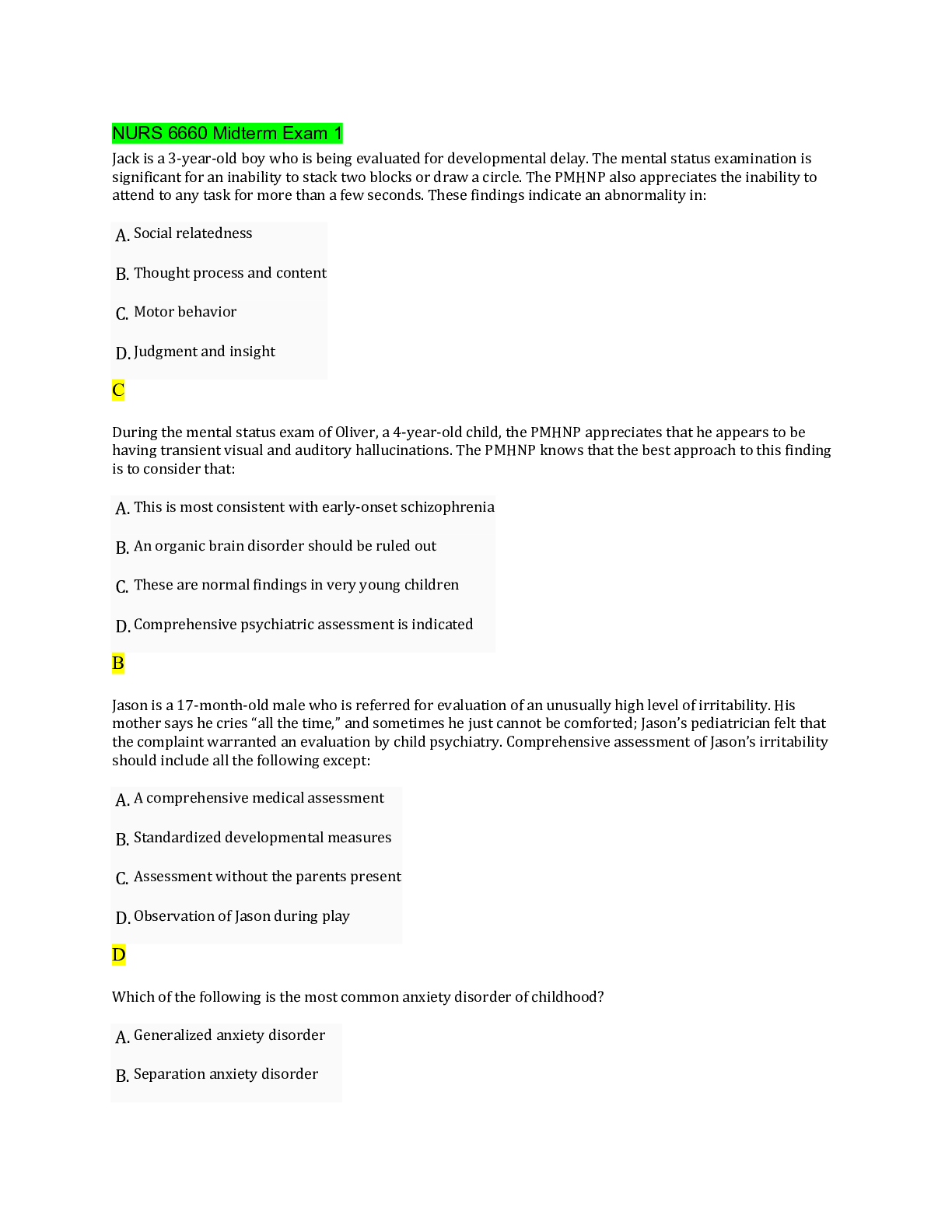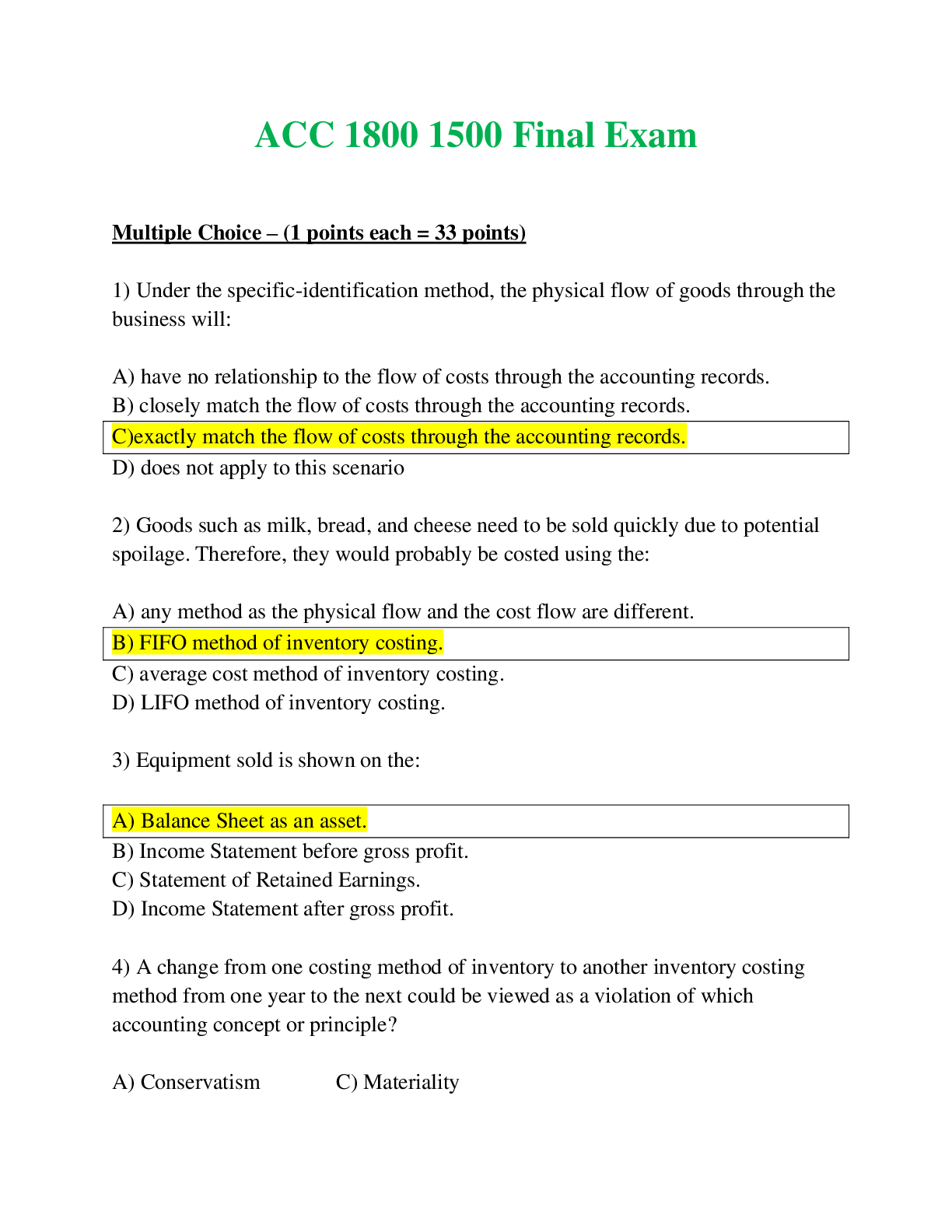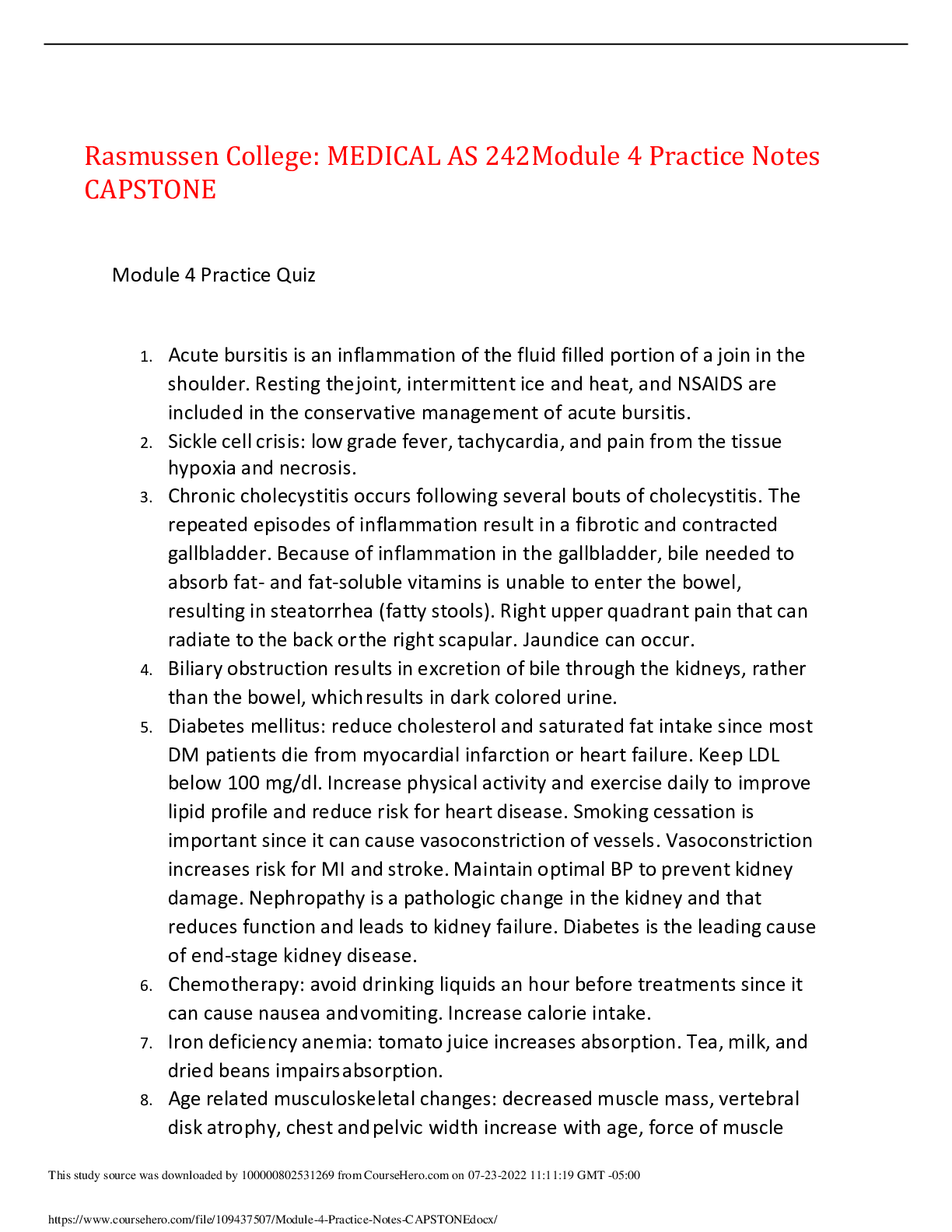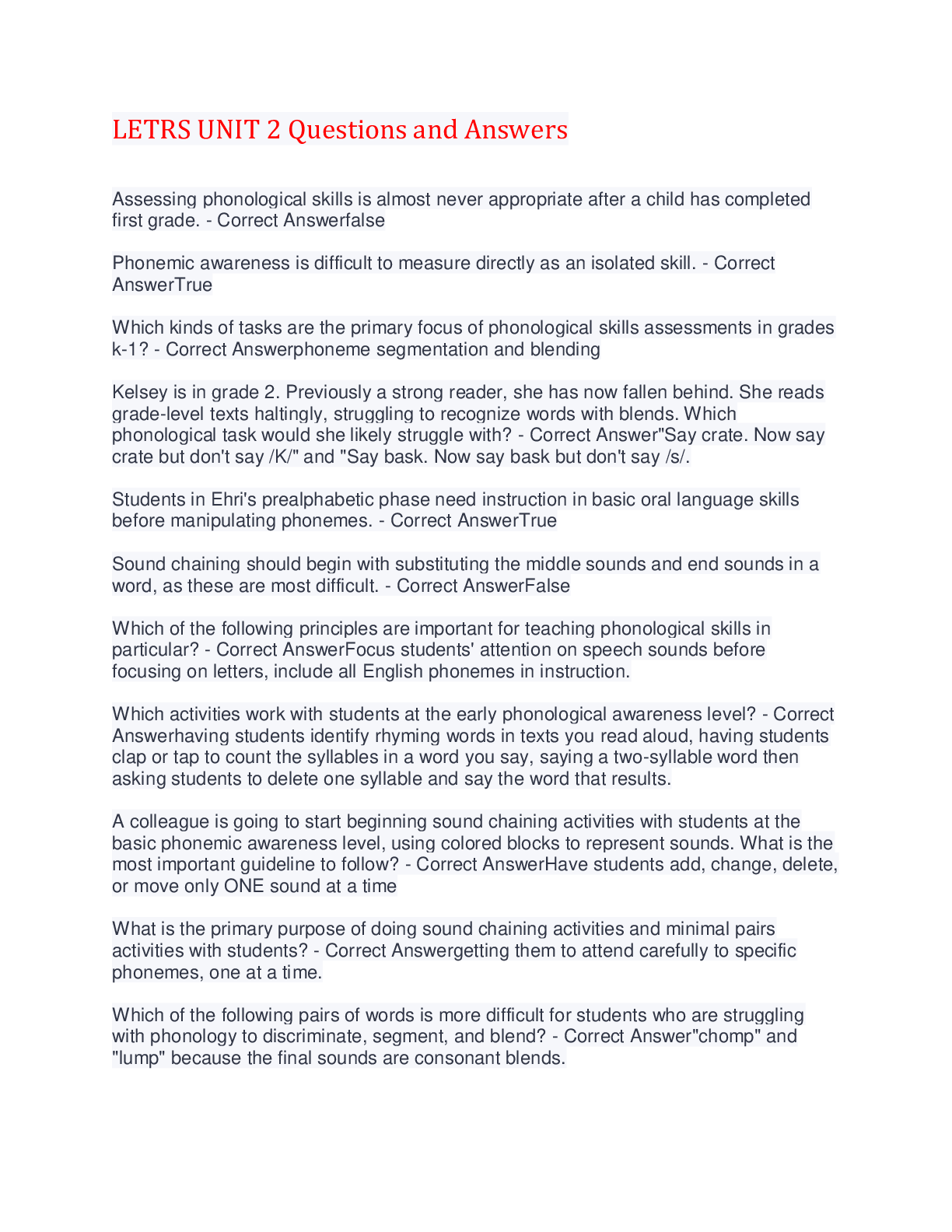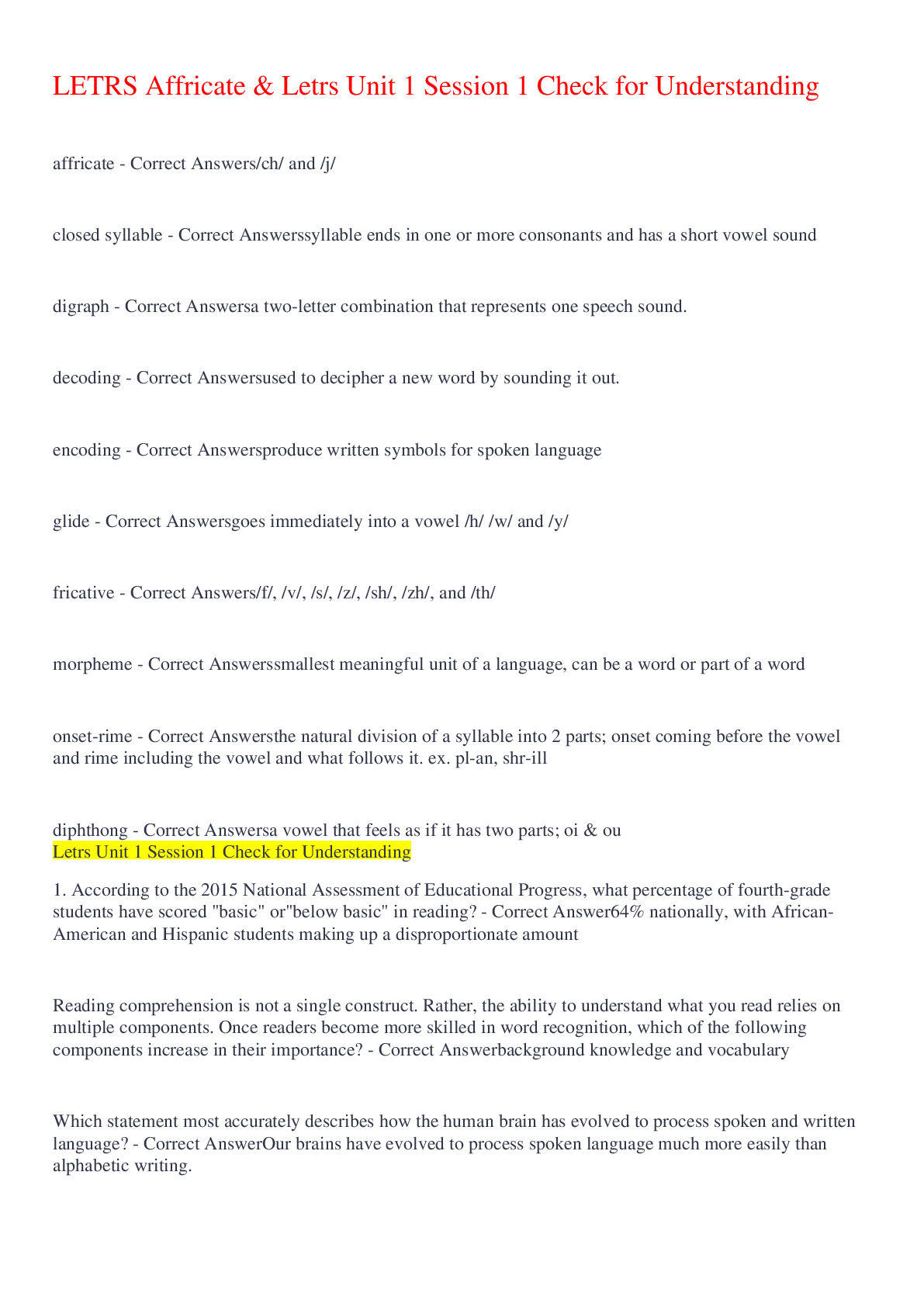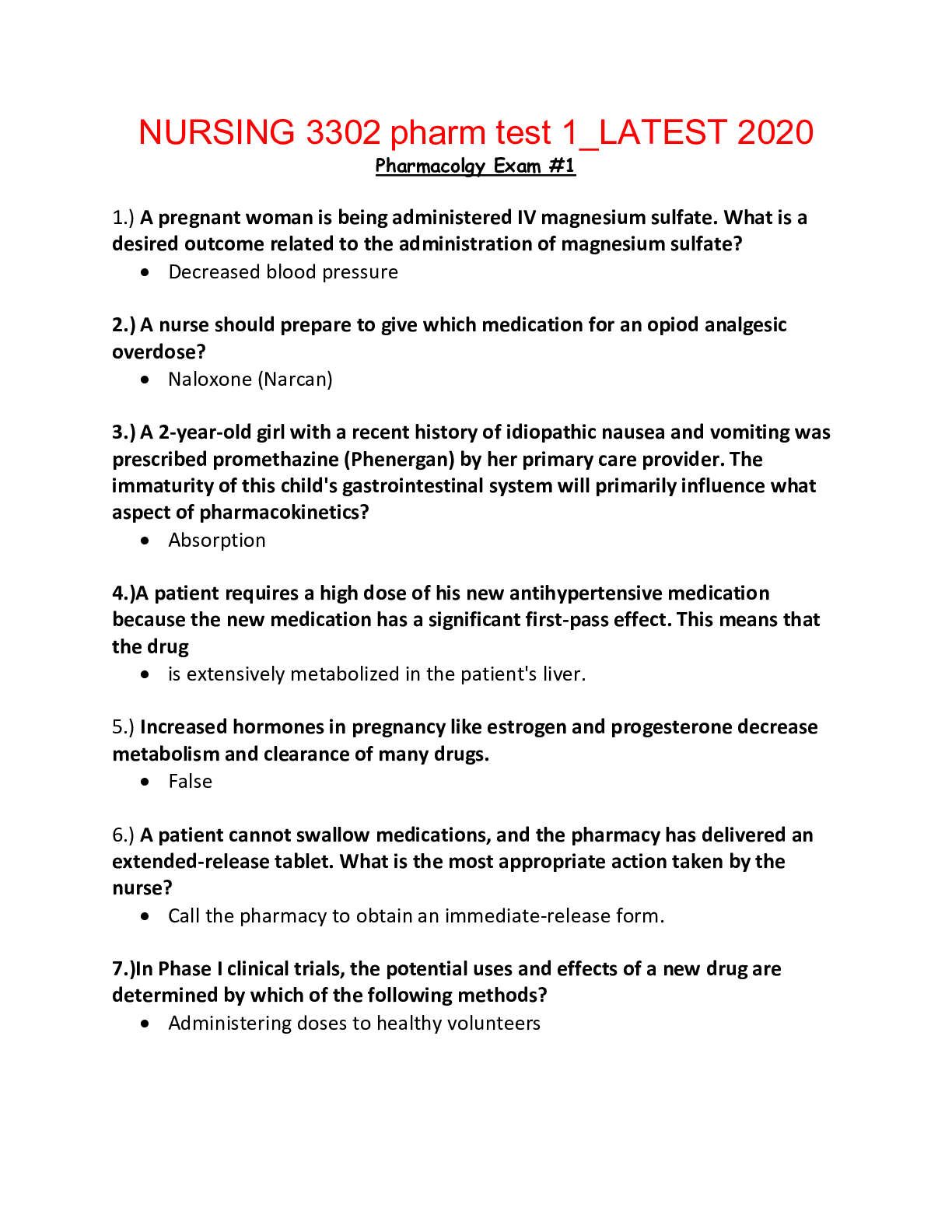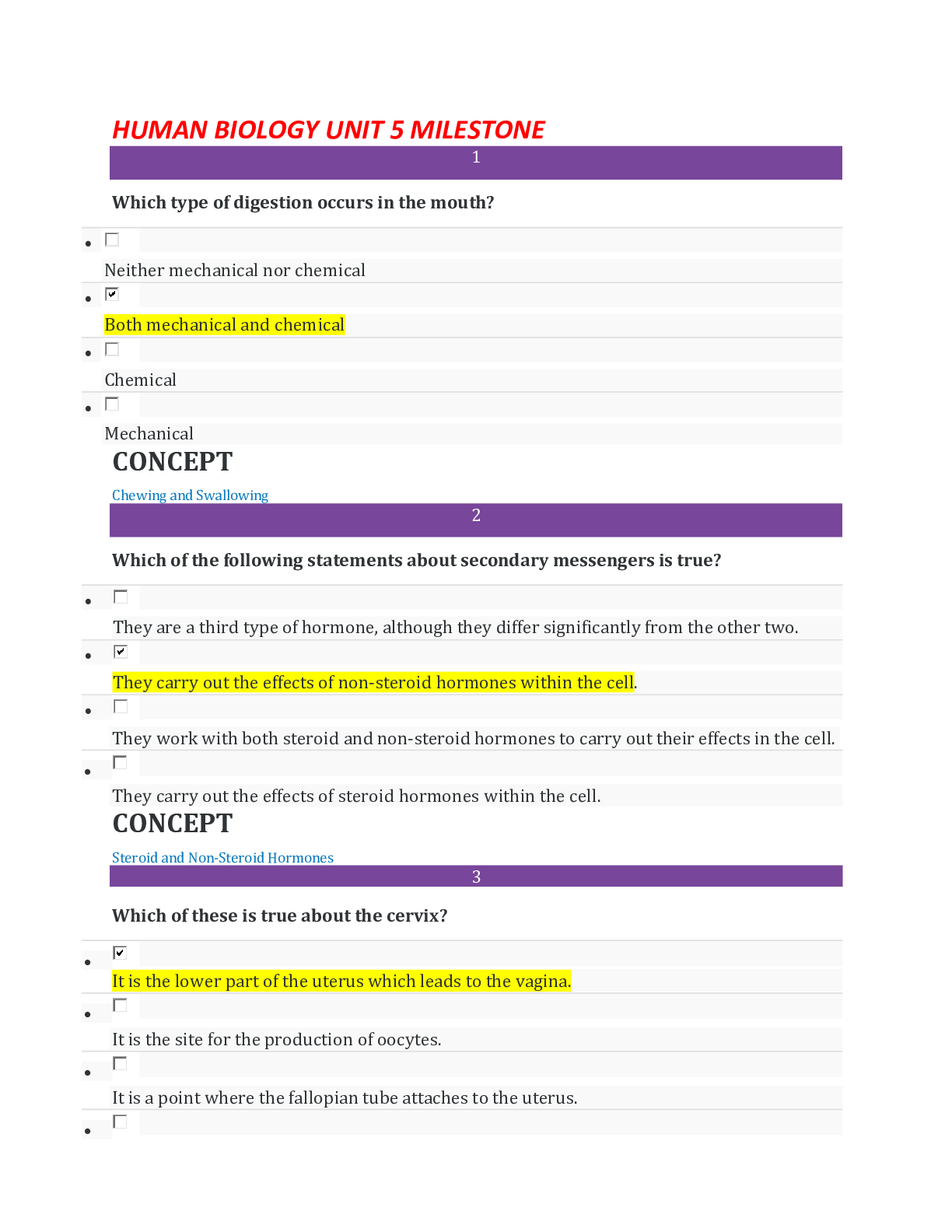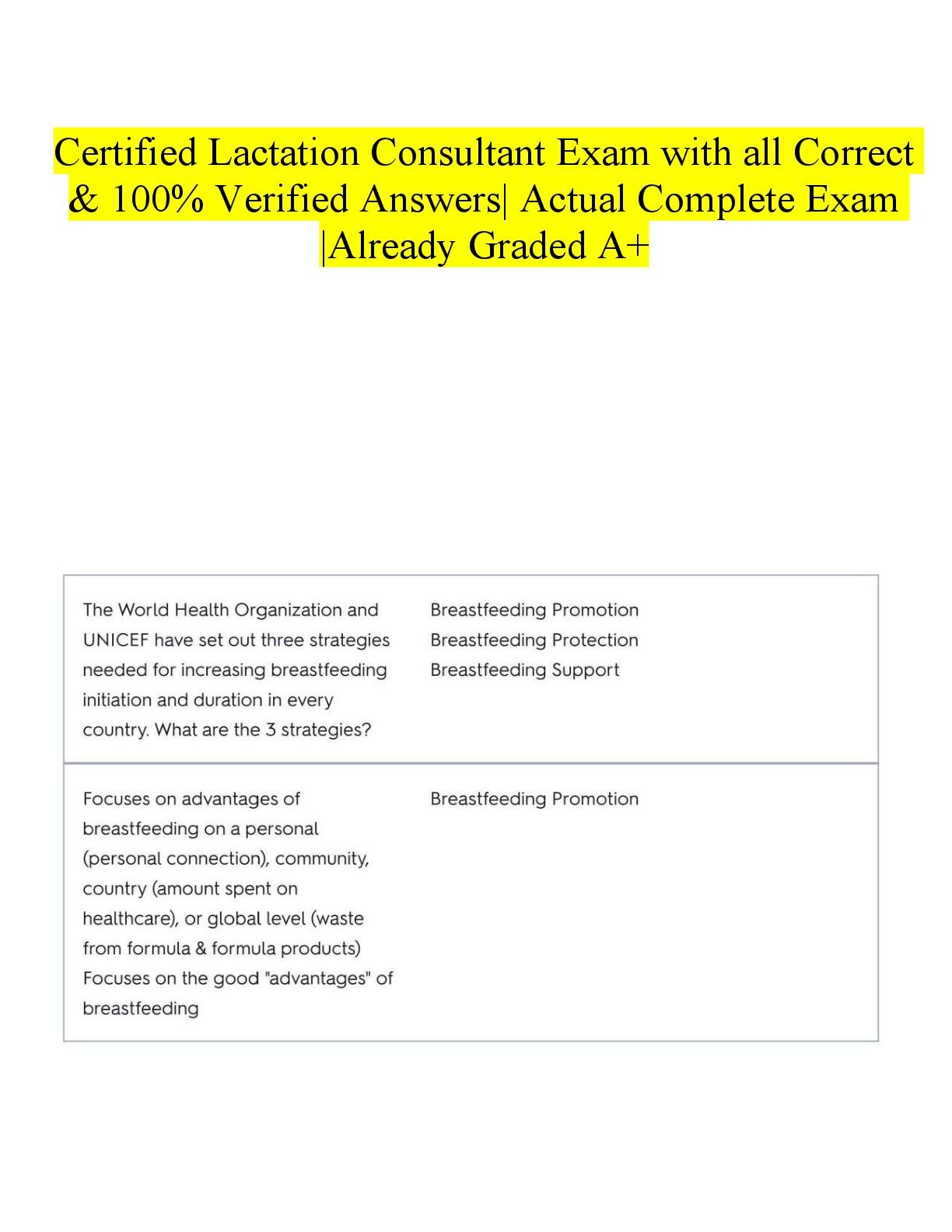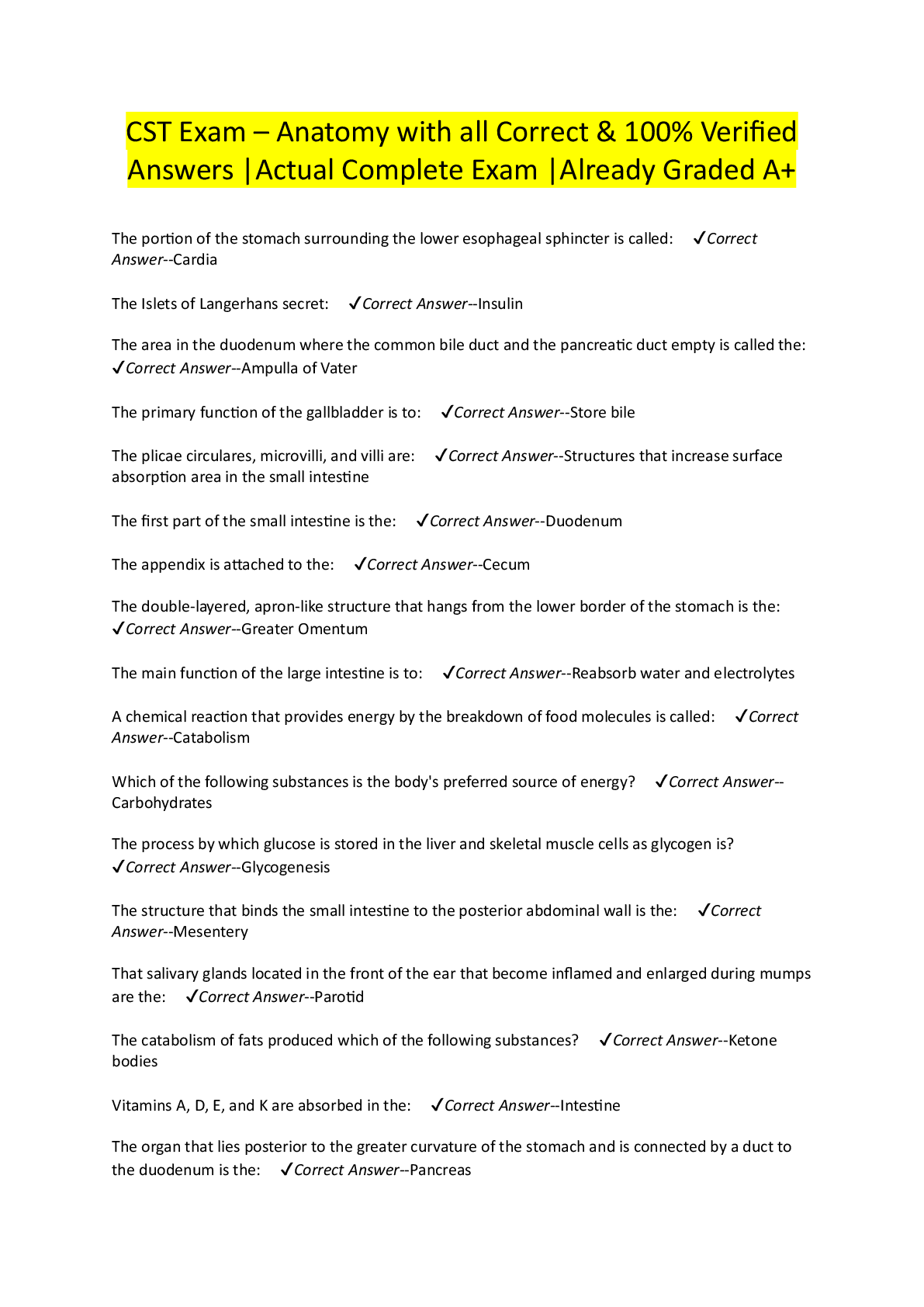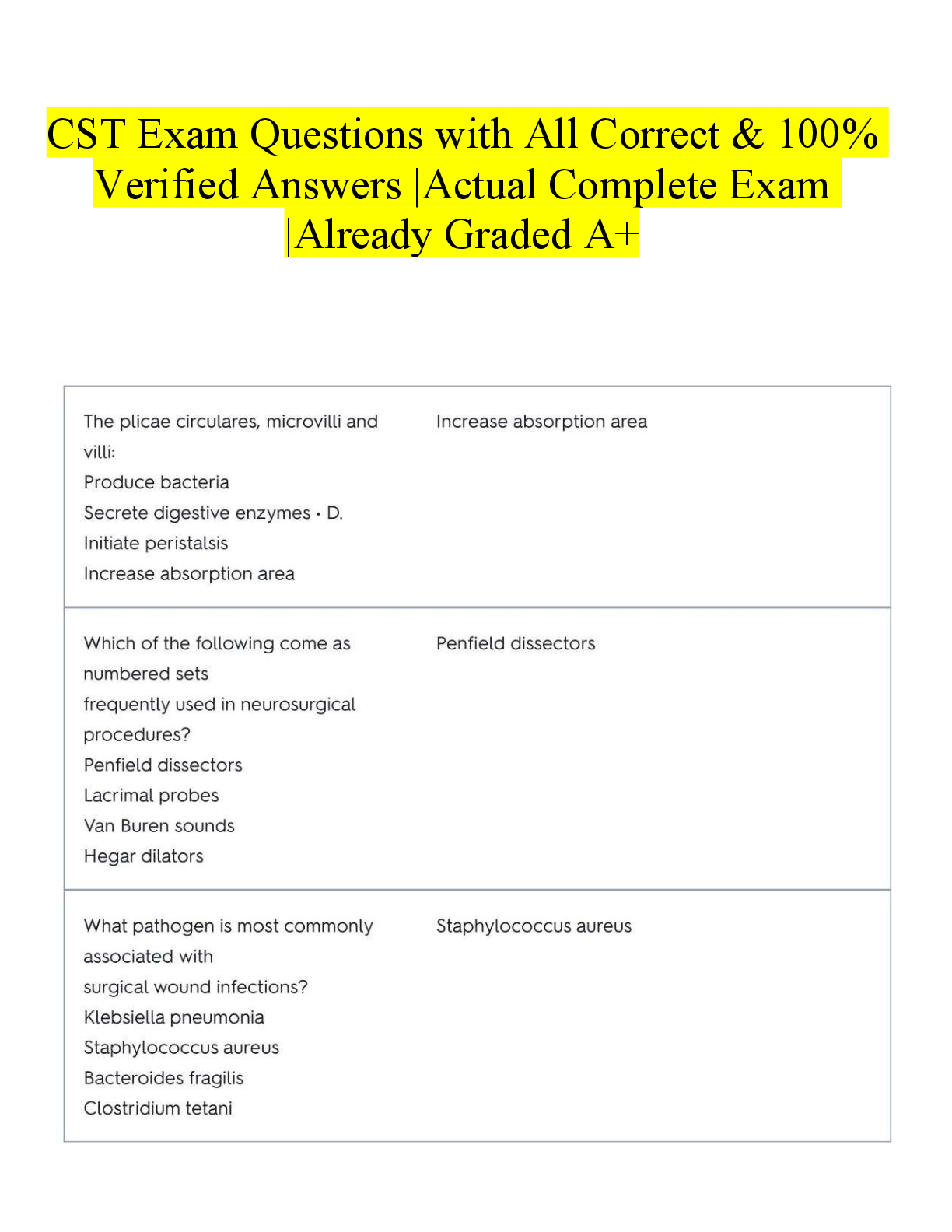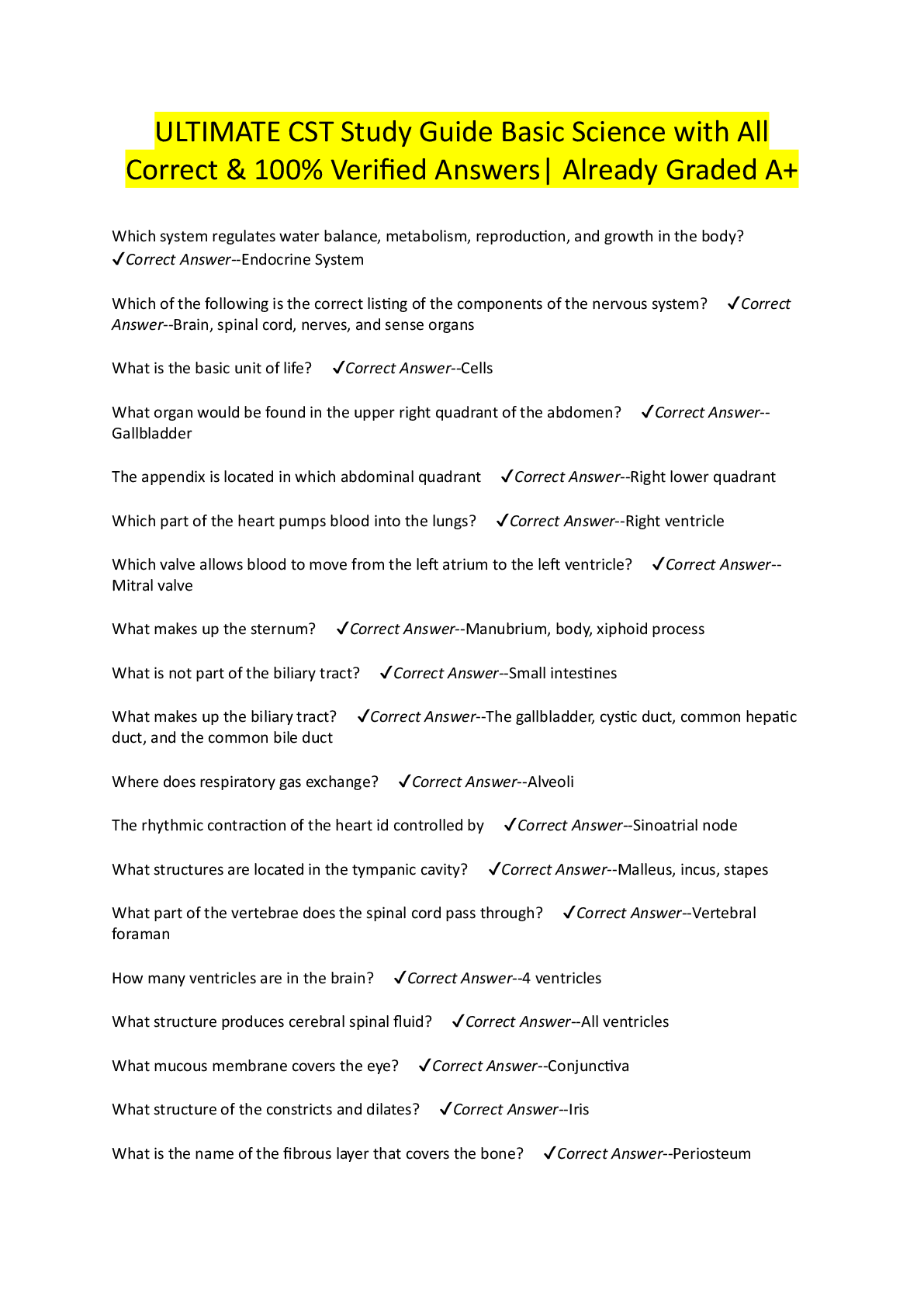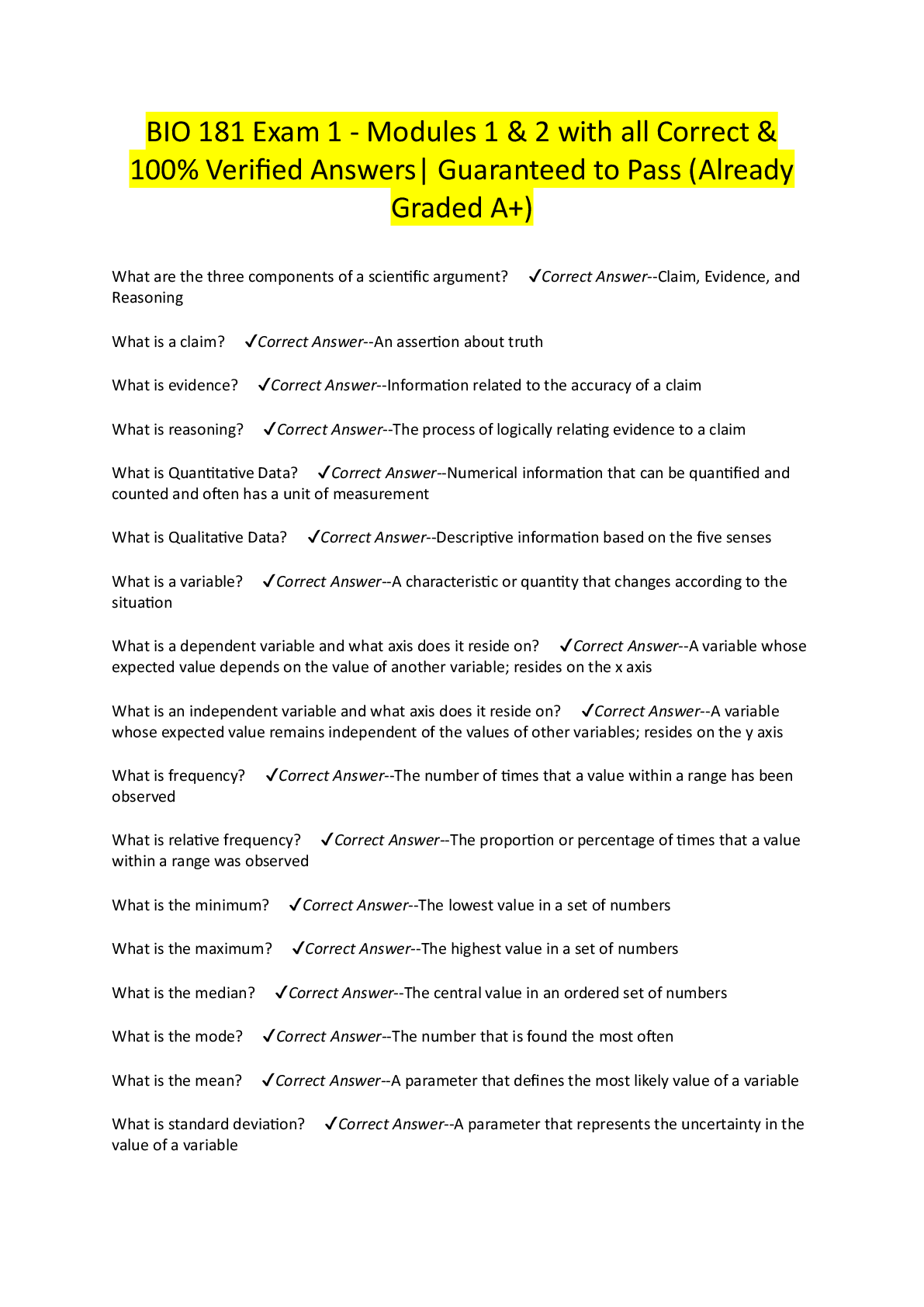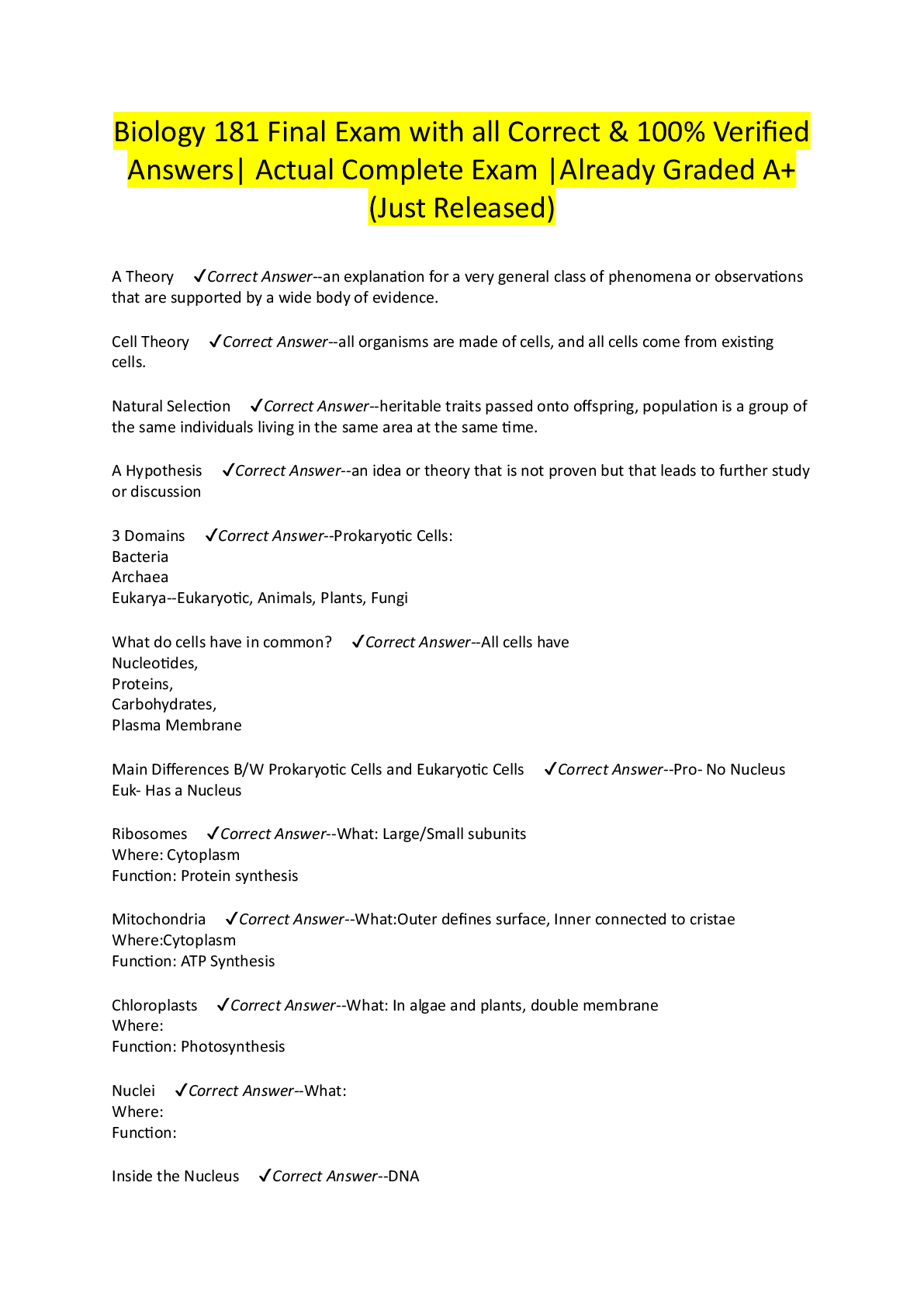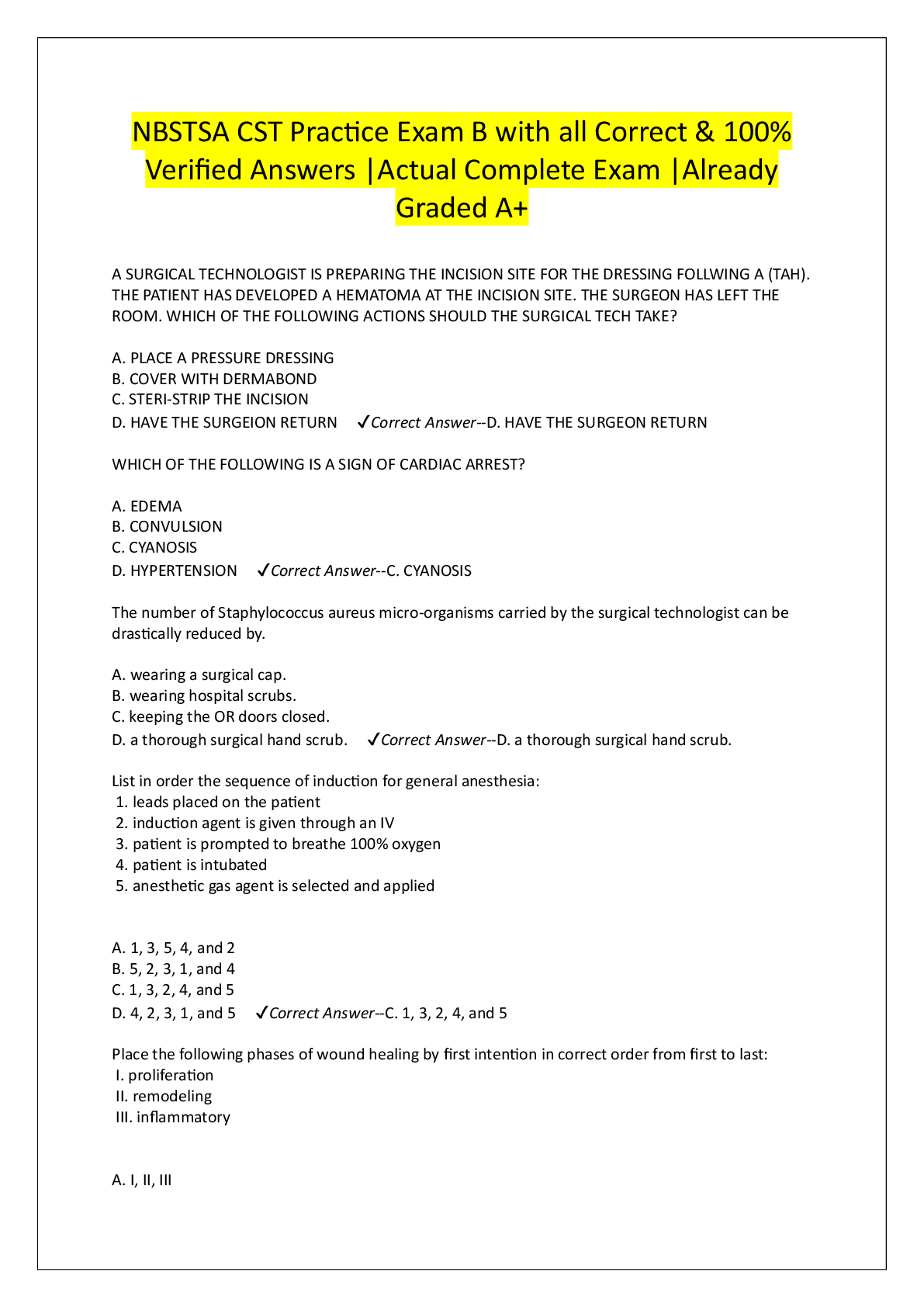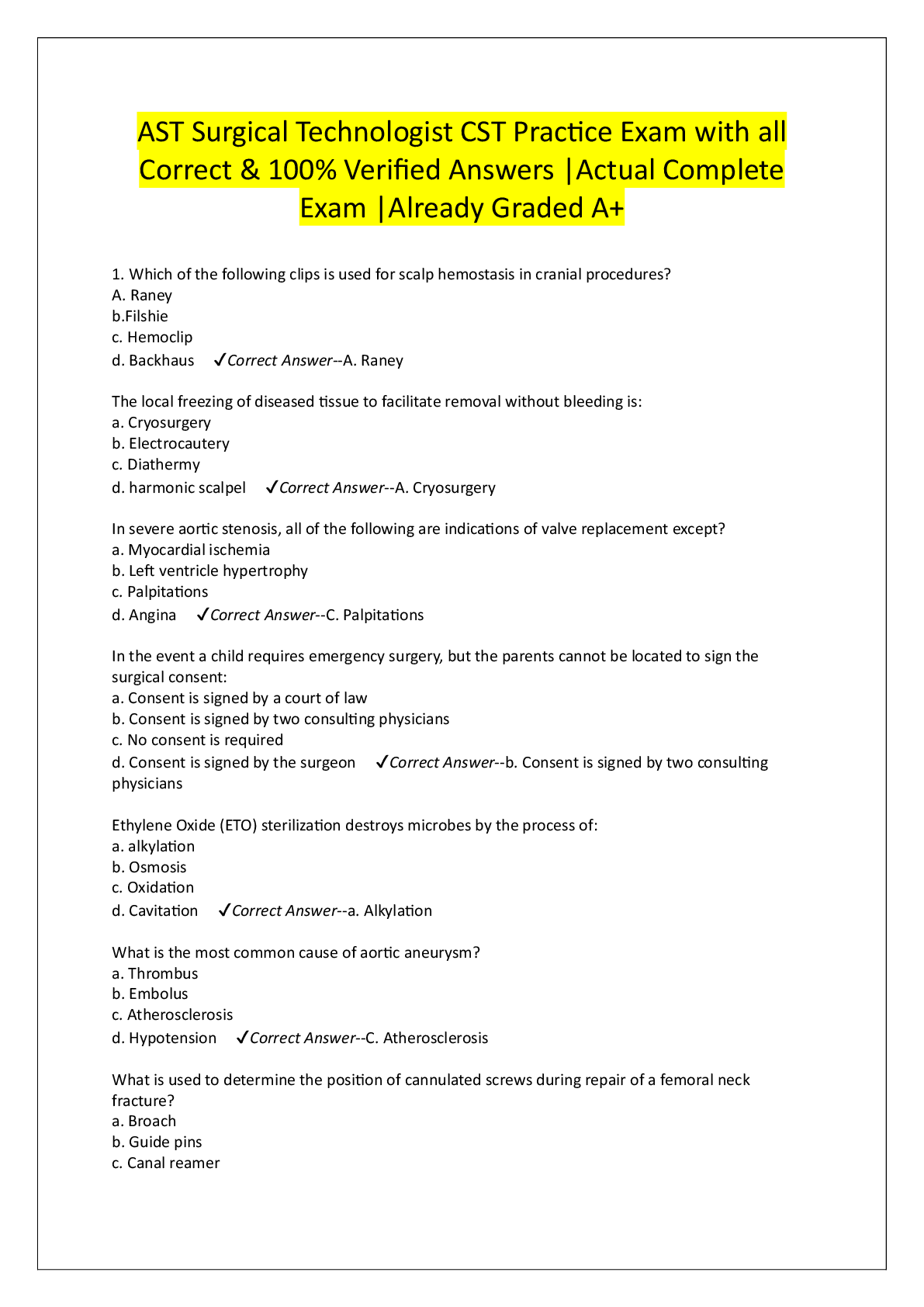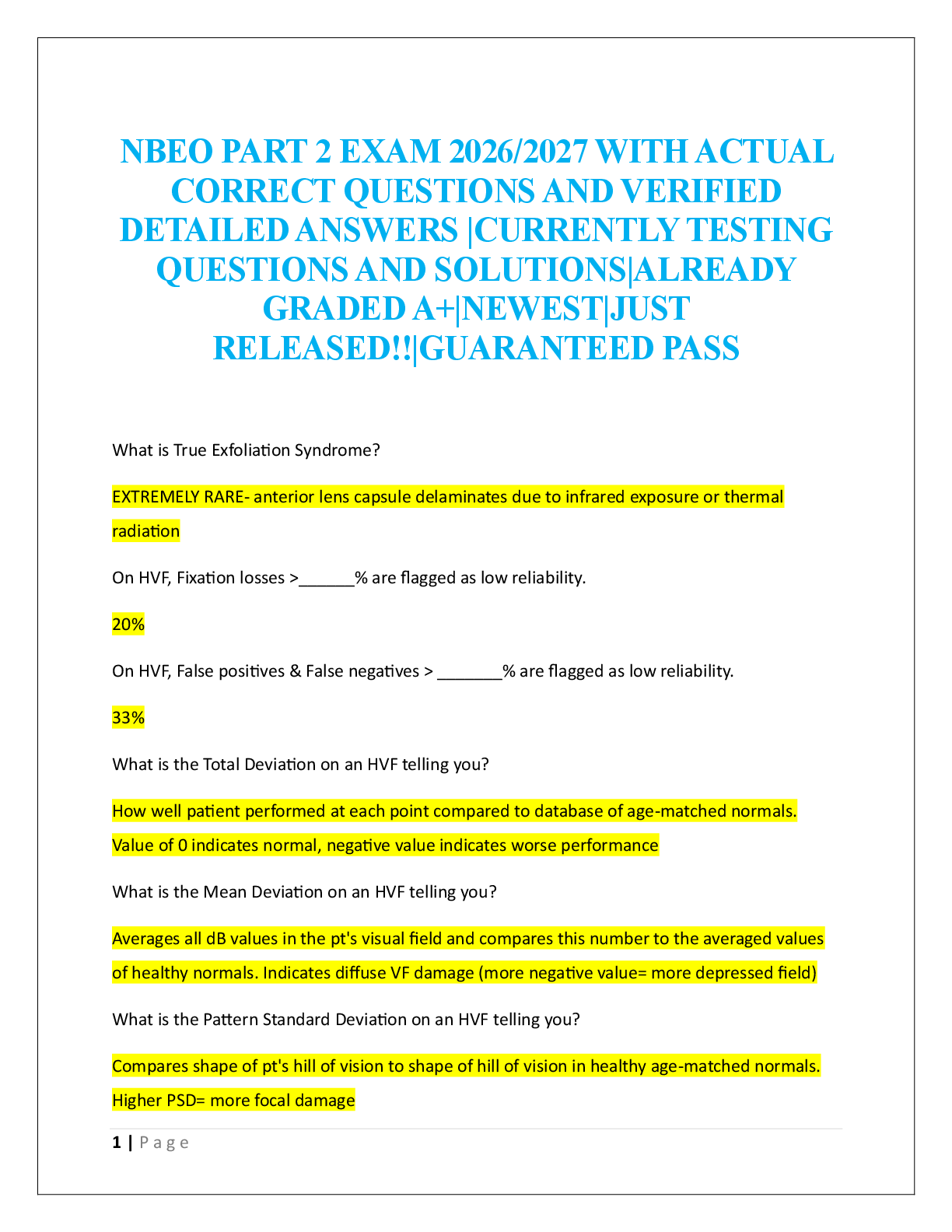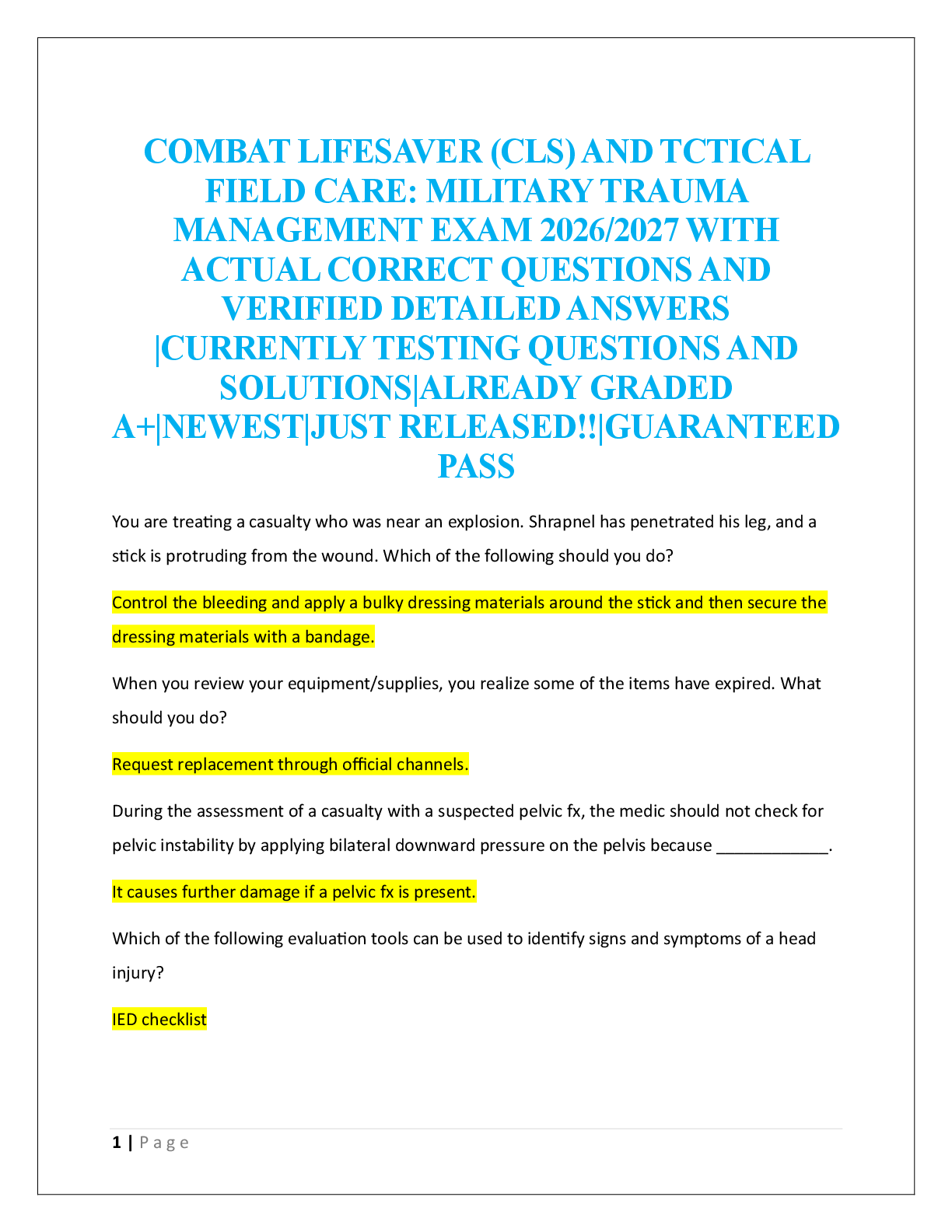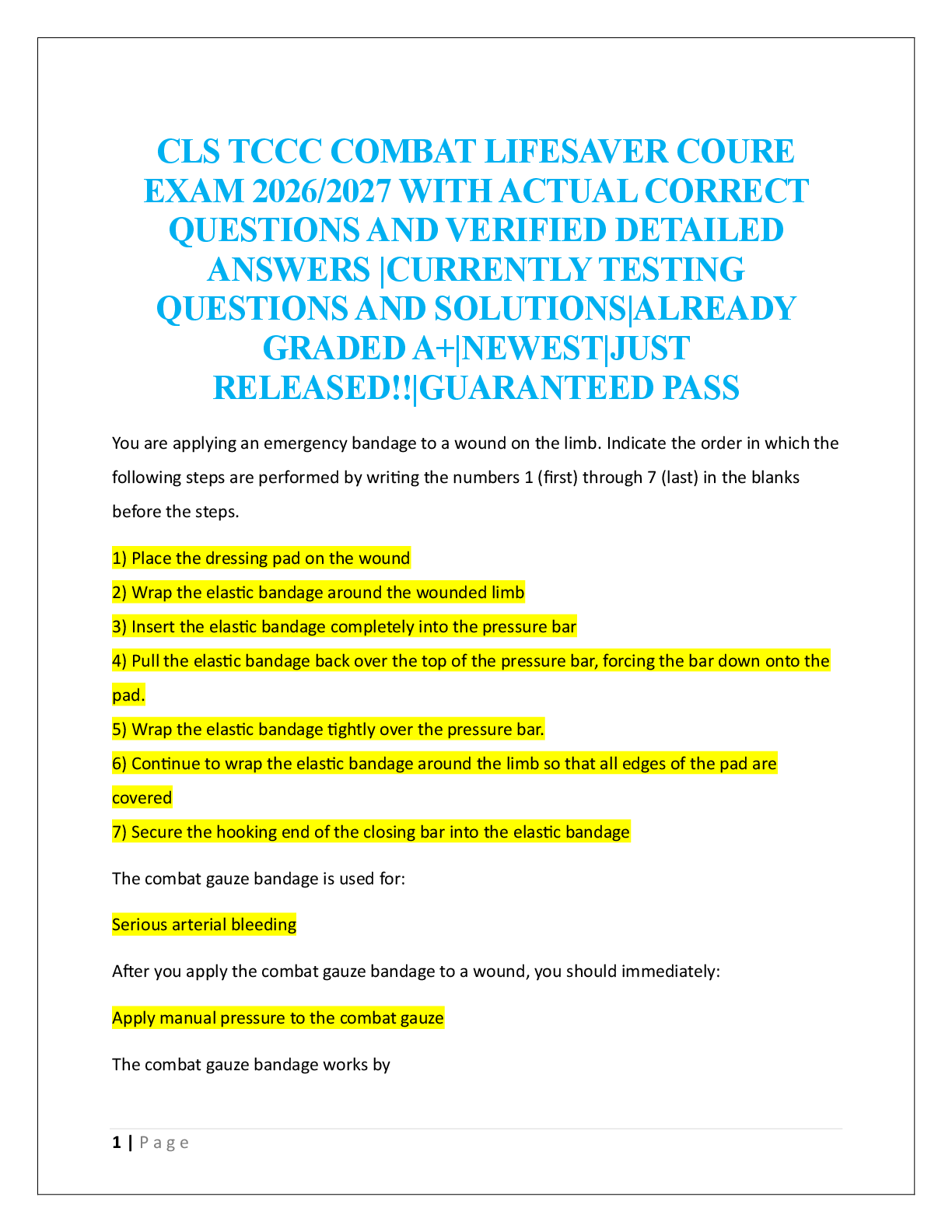HESI EXIT RN EXAM V1 2019,100% CORRECT
Document Content and Description Below
Following discharge teaching, a male client with duodenal ulcer tells the nurse the he will drink plenty of dairy products, such as milk, to help coat and protect his ulcer. What is the best follow-up ... action by the nurse? 2. A male client with hypertension, who received new antihypertensive prescriptions at his last visit returns to the clinic two weeks later to evaluate his blood pressure (BP). His BP is 158/106 and he admits that he has not been taking the prescribed medication because the drugs make him “feel bad”. In explaining the need for hypertension control, the nurse should stress that an elevated BP places the client at risk for which pathophysiological condition? 3. The nurse observes an unlicensed assistive personnel (UAP) positioning a newly admitted client who has a seizure disorder. The client is supine and the UAP is placing soft pillows along the side rails. What action should the nurse implement? 4. An adolescent with major depressive disorder has been taking duloxetine (Cymbalta) for the past 12 days. Which assessment finding requires immediate follow-up? 5. A 60-year-old female client with a positive family history of ovarian cancer has developed an abdominal mass and is being evaluated for possible ovarian cancer. Her Papanicolau (Pap) smear results are negative. What information should the nurse include in the client’s teaching plan? 6. A client who recently underwear a tracheostomy is being prepared for discharge to home. Which instructions is most important for the nurse to include in the discharge plan? 7. In assessing an adult client with a partial rebreather mask, the nurse notes that the oxygen reservoir bag does not deflate completely during inspiration and the client’s respiratory rate is 14 breaths / minute. What action should the nurse implement? 8. During shift report, the central electrocardiogram (EKG) monitoring system alarms. Which client alarm should the nurse investigate firs? 9. During a home visit, the nurse observed an elderly client with diabetes slip and fall. What action should the nurse take first? 10. At 0600 while admitting a woman for a schedule repeat cesarean section (C-Section), the client tells the nurse that she drank a cup a coffee at 0400 because she wanted to avoid getting a headache. Which action should the nurse take first? 11. After placing a stethoscope as seen in the picture, the nurse auscultates S1 and S2 heart sounds. To determine if an S3 heart sound is present, what action should the nurse take first? 12. A 66-year-old woman is retiring and will no longer have a health insurance through her place of employment. Which agency should the client be referred to by the employee health nurse for health insurance needs? 13. A client who is taking an oral dose of a tetracycline complains of gastrointestinal upset. What snack should the nurse instruct the client to take with the tetracycline? 14. Following a lumbar puncture, a client voices several complaints. What complaint indicated to the nurse that the client is experiencing a complication? • “I am having pain in my lower back when I move my legs” • “My throat hurts when I swallow” • “I feel sick to my stomach and am going to throw up” 15. An elderly client seems confused and reports the onset of nausea, dysuria, and urgency with incontinence. Which action should the nurse implement? 16. The nurse is assisting the mother of a child with phenylketonuria (PKU) to select foods that are in keeping with the child’s dietary restrictions. Which foods are contraindicated for this child? 17. Before preparing a client for the first surgical case of the day, a part-time scrub nurse asks the circulating nurse if a 3 minute surgical hand scrub is adequate preparation for this client. Which response should the circulating nurse provide? Which breakfast selection indicates that the client understands the nurse’s instructions about the dietary management of osteoporosis? 18. The charge nurse of a critical care unit is informed at the beginning of the shift that less than the optimal number of registered nurses will be working that shift. In planning assignments, which client should receive the most care hours by a registered nurse (RN)? 19. A mother brings her 6-year-old child, who has just stepped on a rusty nail, to the pediatrician’s office. Upon inspection, the nurse notes that the nail went through the shoe and pierced the bottom of the child’s foot. Which action should the nurse implement first? 20. The mother of an adolescent tells the clinic nurse, “My son has athlete’s foot, I have been applying triple antibiotic ointment for two days, but there has been no improvement.” What instruction should the nurse provide? 21. A 26-year-old female client is admitted to the hospital for treatment of a simple goiter, and levothyroxine sodium (Synthroid) is prescribed. Which symptoms indicate to the nurse that the prescribed dosage is too high for this client? The client experiences • Bradycardia and constipation • Lethargy and lack of appetite • Muscle cramping and dry, flushed skin • Palpitations and shortness of breath 22. A client with a history of heart failure presents to the clinic with a nausea, vomiting, yellow vision and palpitations. Which finding is most important for the nurse to assess to the client? The healthcare provider prescribes an IV solution of isoproterenol (Isuprel) 1 mg in 250 ml of D5W at 300 mcg/hour. The nurse should program the infusion pump to deliver how many ml/hour? (Enter numeric value only.) The pathophysiological mechanism are responsible for ascites related to liver failure? (Select all that apply) • Fluid shifts from intravascular to interstitial area due to decreased serum protein • Increased hydrostatic pressure in portal circulation increases fluid shifts into abdomen • Increased circulating aldosterone levels that increase sodium and water retention 23. The nurse is auscultating a client’s heart sounds. Which description should the nurse use to document this sound? (Please listen to the audio first to select the option that applies) 24. The healthcare provider prescribes celtazidime (Fortax) 35 mg every 8 hours IM for an infant. The 500 mg vial is labeled with the instruction to add 5.3 ml diluent to provide a concentration of 100 mg/ml. How many ml should the nurse administered for each dose? (Enter numeric value only. If rounding is required, round to the nearest tenth) The nurse notes that a client has been receiving hydromorphone (Dilaudid) every six hours for four days. What assessment is most important for the nurse to complete? • Auscultate the client's bowel sounds • Observe for edema around the ankles • Measure the client’s capillary glucose level • Count the apical and radial pulses simultaneously 25. A female client is admitted with end stage pulmonary disease is alert, oriented, and complaining of shortness of breath. The client tells the nurse that she wants “no heroic measures” taken if she stops breathing, and she asks the nurse to document this in her medical record. What action should the nurse implement? A client is receiving a full strength continuous enteral tube feeding at 50 ml/hour and has developed diarrhea. The client has a new prescription to change the feeding to half strength. What intervention should the nurse implement? 26. A female client reports that her hair is becoming coarse and breaking off, that the outer part of her eyebrows have disappeared, and that her eyes are all puffy. Which follow-up question is best for the nurse to ask? 27. After a third hospitalization 6 months ago, a client is admitted to the hospital with ascites and malnutrition. The client is drowsy but responding to verbal stimuli and reports recently spitting up blood. What assessment finding warrants immediate intervention by the nurse? • Capillary refill of 8 seconds • bruises on arms and legs • round and tight abdomen • pitting edema in lower legs 28. After the nurse witnesses a preoperative client sign the surgical consent form, the nurse signs the form as a witness. What are the legal implications of the nurse’s signature on the client’s surgical consent form? (Select all that apply) 29. Following surgery, a male client with antisocial personality disorder frequently requests that a specific nurse be assigned to his care and is belligerent when another nurse is assigned. What action should the charge nurse implement? A client with cervical cancer is hospitalized for insertion of a sealed internal cervical radiation implant. While providing care, the nurse finds the radiation implant in the bed. What action should the nurse take? 30. The client with which type of wound is most likely to need immediate intervention by the nurse? • Laceration • Abrasion • Contusion • Ulceration 31. The nurse is planning care for a client admitted with a diagnosis of pheochromocytoma. Which intervention has the highest priority for inclusion in this client’s plan of care? When caring for a client who has acute respiratory distress syndrome (ARDS), the nurse elevates the head of the bed 30 degrees. What is the reason for this intervention? • To reduce abdominal pressure on the diaphragm • to promote retraction of the intercostal accessory muscle of respiration • to promote bronchodilation and effective airway clearance • to decrease pressure on the medullary center which stimulates breathing 32. When assessing a mildly obese 35-year-old female client, the nurse is unable to locate the gallbladder when palpating below the liver margin at the lateral border of the rectus abdominal muscle. What is the most likely explanation for failure to locate the gallbladder by palpation? • The client is too obese • Palpating in the wrong abdominal quadrant • Deeper palpation technique is needed 33. A woman with an anxiety disorder calls her obstetrician’s office and tells the nurse of increased anxiety since the normal vaginal delivery of her son three weeks ago. Since she is breastfeeding, she stopped taking her antianxiety medications, but thinks she may need to start taking them again because of her increased anxiety. What response is best for the nurse to provide this woman? • describe the transmission of drugs to the infant through breast milk • encourage her to use stress relieving alternatives, such as deep breathing exercises • Inform her that some antianxiety medications are safe to take while breastfeeding • Explain that anxiety is a normal response for the mother of a 3-week-old. 34. An older male client with a history of type 1 diabetes has not felt well the past few days and arrives at the clinic with abdominal cramping and vomiting. He is lethargic, moderately, confused, and cannot remember when he took his last dose of insulin or ate last. What action should the nurse implement first? • Start an intravenous (IV) infusion of normal saline • obtain a serum potassium level • administer the client's usual dose of insulin • assess pupillary response to light 35. A client who received multiple antihypertensive medications experiences syncope due to a drop in blood pressure to 70/40. What is the rationale for the nurse’s decision to hold the client’s scheduled antihypertensive medication? • increased urinary clearance of the multiple medications has produced diuresis and lowered the blood pressure • the antagonistic interaction among the various blood pressure medications has reduced their effectiveness • The additive effect of multiple medications has caused the blood pressure to drop too low • the synergistic effect of the multiple medications has resulted in drug toxicity and resulting hypotension 36. Which client is at the greatest risk for developing delirium? • An adult client who cannot sleep due to constant pain. • an older client who attempted 1 month ago • a young adult who takes antipsychotic medications twice a day • a middle-aged woman who uses a tank for supplemental oxygen 37. Which intervention should the nurse include in a long-term plan of care for a client with Chronic Obstructive Pulmonary Disease (COPD)? • Reduce risks factors for infection • Administer high flow oxygen during sleep • Limit fluid intake to reduce secretions • Use diaphragmatic breathing to achieve better exhalation 38. Which location should the nurse choose as the best for beginning a screening program for hypothyroidism? • A business and professional women's group. • An African-American senior citizens center • A daycare center in a Hispanic neighborhood • An after-school center for Native-American teens 39. A female client has been taking a high dose of prednisone, a corticosteroid, for several months. After stopping the medication abruptly, the client reports feeling “very tired”. Which nursing intervention is most important for the nurse to implement? • Measure vital signs • Auscultate breath sounds • Palpate the abdomen • Observe the skin for bruising 40. A male client reports the onset of numbness and tingling in his fingers and around his mouth. Which lab is important for the nurse to review before contacting the health care provider? • capillary glucose • urine specific gravity • Serum calcium • white blood cell count 41. What explanation is best for the nurse to provide a client who asks the purpose of using the log-rolling technique for turning? • working together can decrease the risk for back injury • The technique is intended to maintain straight spinal alignment. • Using two or three people increases client safety. • turning instead of pulling reduces the likelihood of skin damage 42. A client receiving chemotherapy has severe neutropenia. Which snack is best for the nurse to recommend to the client? Which action should the school nurse take first when conducting a screening for scoliosis? 43. An unlicensed assistive personnel (UAP) assigned to obtain client vital signs reports to the charge nurse that a client has a weak pulse with a rate of 44 beat/ minutes. What action should the charge nurse implement? After a sudden loss of consciousness, a female client is taken to the ED and initial assessment indicate that her blood glucose level is critically low. Once her glucose level is stabilized, the client reports that was recently diagnosed with anorexia nervosa and is being treated at an outpatient clinic. Which intervention is more important to include in this client’s discharge plan? 44. A client with a peripherally inserted central catheter (PICC) line has a fever. What client assessment is most important for the nurse to perform? 45. The nurse administers an antibiotic to a client with respiratory tract infection. To evaluate the medication’s effectiveness, which laboratory values should the nurse monitor? Select all that apply 46. A client is admitted to isolation with the diagnosis of active tuberculosis. Which infection control measures should the nurse implement? • Negative pressure environment • contact precautions • droplet precautions • protective environment 47. A school nurse is called to the soccer field because a child has a nose bleed (epistaxis). In what position should the nurse place the child? 48. A young adult who is hit with a baseball bat on the temporal area of the left skull is conscious when admitted to the ED and is transferred to the Neurological Unit to be monitored for signs of closed head injury. Which assessment finding is indicative of a developing epidural hematoma? 49. A female client with breast cancer who completed her first chemotherapy treatment today at an out-patient center is preparing for discharge. Which behavior indicates that the client understands her care needs 50. Which instruction should the nurse provide a pregnant client who is complaining of heartburn? A client is admitted to the intensive care unit with diabetes insipidus due to a pituitary gland tumor. Which potential complication should the nurse monitor closely? • Hypokalemia • Ketonuria. • Peripheral edema • Elevated blood pressure 51. A female client reports she has not had a bowel movement for 3 days, but now is defecating frequent small amount of liquid stool. Which action should the nurse implement? 52. After changing to a new brand of laundry detergent, an adult male reports that he has a fine itchy rash. Which assessment finding warrants immediate intervention by the nurse? 53. The nurse should teach the parents of a 6 year-old recently diagnosed with asthma that the symptom of acute episode of asthma are due to which physiological response? 54. A 10 year old who has terminal brain cancer asks the nurse, "What will happen to my body when I die?" How should the nurse respond? 55. The nurse is assessing a 3-month-old infant who had a pylorotomy yesterday. This child should be medicated for pain based on which findings? Select all that apply: • Restlessness • Clenched Fist • Increased pulse rate • Increased respiratory rate. • Increased temperature • Peripheral pallor of the skin 56. The nurse is preparing to administer an oral antibiotic to a client with unilateral weakness, ptosis, mouth drooping and, aspiration pneumonia. What is the priority nursing assessment that should be done before administering this medication? 57. The nurse who is working on a surgical unit receives change of shift report on a group of clients for the upcoming shift. A client with which condition requires the most immediate attention by the nurse? • Gunshot wound three hours ago with dark drainage of 2 cm noted on the dressing. • Mastectomy 2 days ago with 50 ml bloody drainage noted in the Jackson-pratt drain. • Collapsed lung after a fall 8h ago with 100 ml blood in the chest tube collection container • Abdominal-perineal resection 2 days ago with no drainage on dressing who has fever and chills. 58. The nurse is caring for a client who had gastric bypass surgery yesterday. Which intervention is most important for the nurse to implement during the first 24 postoperative hours? . 59. When preparing to discharge a male client who has been hospitalized for an adrenal crisis, the client expresses concern about having another crisis. He tells the nurse that he wants to stay in the hospital a few more days. Which intervention should the nurse implement? 60. An adult female client tells the nurse that though she is afraid her abusive boyfriend might one day kill her, she keeps hoping that he will change. What action should the nurse take first? 61. In caring for a client with Cushing syndrome, which serum laboratory value is most important for the nurse to monitor? • Lactate • Glucose • Hemoglobin • Creatinine 62. Azithromycin is prescribed for an adolescent female who has lower lobe pneumonia and recurrent chlamydia. What information is most important for the nurse to provide to this client? 63. A client in the emergency center demonstrates rapid speech, flight of ideas, and reports sleeping only three hours during the past 48h. Based on these finding, it is most important for the nurse to review the laboratory value for which medication? A male client who is admitted to the mental health unit for treatment of bipolar disorder has a slightly slurred speech pattern and an unsteady gait. Which assessment finding is most important for the nurse to report to the healthcare provider? A client was admitted to the cardiac observation unit 2 hours ago complaining of chest pain. On admission, the client’s EKG showed bradycardia, ST depression, but no ventricular ectopy. The client suddenly reports a sharp increase in pain, telling the nurse, “I feel like an elephant just stepped on my chest” The EKG now shows Q waves and ST segment elevations in the anterior leads. What intervention should the nurse perform? 64. The nurse is developing a teaching program for the community. What population characteristic is most influential when choosing strategies for implementing a teaching plan? 65. A client is being discharged with a prescription for warfarin (Coumadin). What instruction should the nurse provide this client regarding diet? 66. A client who had a small bowel resection acquired methicillin resistant staphylococcus aureus (MRSA) while hospitalized. He treated and released, but is readmitted today because of diarrhea and dehydration. It is most important for the nurse to implement which intervention. 67. A postoperative female client has a prescription for morphine sulfate 10 mg IV q3 hours for pain. One dose of morphine was administered when the client was admitted to the post anesthesia care unit (PACU) and 3 hours later, the client is again complaining of pain. Her current respiratory rate is 8 breaths/minute. What action should the nurse take? 68. Which intervention is most important for the nurse to include in the plan of care for an older woman with osteoporosis? 69. Based on the information provided in this client’s medical record during labor, which should the nurse implement? (Click on each chart tab for additional information. Please be sure to scroll to the bottom right corner of each tab to view all information contained in the client’s medical record.) . 70. An unlicensed assistive personnel UAP leaves the unit without notifying the staff. In what order should the unit manager implement this intervention to address the UAPs behavior? (Place the action in order from first on top to last on bottom.) 1. Note date and time of the behavior. 2. Discuss the issue privately with the UAP. 3. Plan for scheduled break times. 4. Evaluate the UAP for signs of improvement. 71. A client with intestinal obstructions has a nasogastric tube to low intermittent suction and is receiving an IV of lactated ringer’s at 100 ml/H. which finding is most important for the nurse to report to the healthcare provider? 72. Which type of Leukocyte is involved with allergic responses and the destruction of parasitic worms? • Neutrophils • Lymphocytes • Eosinophils • Monocytes 73. The healthcare provider prescribes the antibiotic cephradine 500mg PO every 6 hours for a client with a postoperative wound infection. Which foods should the nurse encourage this client to eat? 74. Several months after a foot injury, and adult woman is diagnosed with neuropathic pain. The client describes the pain as severe and burning and is unable to put weight on her foot. She asks the nurse when the pain will “finally go away.” How should the nurse respond? 75. One day following an open reduction and internal fixation of a compound fracture of the leg, a male client complains of “a tingly sensation” in his left foot. The nurse determines the client’s left pedal pulses are diminished. Based on these finding, what is the client’s greatest risk? 76. The nurse is completing a head to be assessment for a client admitted for observation after falling out of a tree. Which finding warrants immediate intervention by the nurse? 77. A client with multiple sclerosis (MS) has decreased motor function after taking a hot bath (Uhthoff’s sign). Which pathophysiological mechanism supports this response? 78. While assessing a radial artery catheter, the client complains of numbness and pain distal to the insertion site. What interventions should the nurse implement? 79. A client is admitted with an epidural hematoma that resulted from a skateboarding accident. To differentiate the vascular source of the intracranial bleeding, which finding should the nurse monitor? 80. The nurse finds a client at 33 weeks gestation in cardiac arrest. What adaptation to cardiopulmonary resuscitation (CPR) should the nurse implement? 81. When preparing a client for discharge from the hospital following a cystectomy and a urinary diversion to treat bladder cancer, which instruction is most important for the nurse to include in the client’s discharge teaching plan? . 82. For the past 24 hours, an antidiarrheal agent, diphenoxylate, has been administered to a bedridden, older client with infectious gastroenteritis. Which finding requires the nurse to take further action? 83. After repositioning an immobile client, the nurse observes an area of hyperemia. To assess for blanching, what action should the nurse take? 84. The nurse enters a client’s room and observes the client’s wrist restraint secured as seen in the picture. What action should the nurse take? 85. A female client with acute respiratory distress syndrome (ARDS) is chemically paralyzed and sedated while she is on as assist-control ventilator using 50% FIO2. Which assessment finding warrants immediate intervention by the nurse? 86. The development of atherosclerosis is a process of sequential events. Arrange the pathophysiological events in orders of occurrence. (Place the first event on top and the last on the bottom) 1. Arterial endothelium injury causes inflammation 2. Macrophages consume low density lipoprotein (LDL), creating foam cells 3. Foam cells release growth factors for smooth muscle cells 4. Smooth muscle grows over fatty streaks creating fibrous plaques 5. Vessel narrowing results in ischemia 87. Following a motor vehicle collision, an adult female with a ruptured spleen and a blood pressure of 70/44, had an emergency splenectomy. Twelve hours after the surgery, her urine output is 25 ml/hour for the last two hours. What pathophysiological reason supports the nurse’s decision to report this finding to the healthcare provider? 88. A nurse-manager is preparing the curricula for a class for charge nurses. A staffing formula based on what data ensures quality client care and is most cost-effective? 89. When performing postural drainage on a client with Chronic Obstructive Pulmonary Disease (COPD), which approach should the nurse use? 90. A client presents in the emergency room with right-sided facial asymmetry. The nurse asks the client to perform a series of movements that require use of the facial muscles. What symptoms suggest that the client has most likely experience a Bell’s palsy rather than a stroke? 91. The nurse is teaching a client how to perform colostomy irrigations. When observing the client’s return demonstration, which action indicated that the client understood the teaching? 92. The nurse should teach the client to observe which precaution while taking dronedarone? 93. A client who sustained a head injury following an automobile collision is admitted to the hospital. The nurse include the client’s risk for developing increased intracranial pressure (ICP) in the plan of care. Which signs indicate to the nurse that ICP has increased? • Increased Glasgow coma scale score. • Nuchal rigidity and papilledema. • Confusion and papilledema • Periorbital ecchymosis. 94. The nurse is caring for a client receiving continuous IV fluids through a single lumen central venous catheter (CVC). Based on the CVC care bundle, which action should be completed daily to reduce the risk for infection? 95. During an annual physical examination, an older woman’s fasting blood sugar (FBS) is determined to be 140 mg/dl or 7.8 mmol/L (SI). Which additional finding obtained during a follow-up visit 2 weeks later is most indicative that the client has diabetes mellitus (DM)? 96. A new mother tells the nurse that she is unsure if she will be able to transition into parenthood. What action should the nurse take? 97. A client who was admitted yesterday with severe dehydration is complaining of pain a 24 gauge IV with normal saline is infusing at a rate of 150 ml/hour. Which intervention should the nurse implement first? 98. An elderly female is admitted because of a change in her level of sensorium. During the evening shift, the client attempts to get out bed and falls, breaking her left hip. Buck’s skin traction is applied to the left leg while waiting for surgery. Which intervention is most important for the nurse to include in this client’s plan care? 99. An Unna boot is applied to a client with a venous stasis ulcer. One week later, when the Unna boot is removed during a follow-up appointment, the nurse observes that the ulcer site contains bright red tissue. What action should the nurse take in response to this finding? . 100. At the end of a preoperative teaching session on pain management techniques, a client starts to cry and states, “I just know I can’t handle all the pain.” What is the priority nursing diagnosis for this client? 101. The nurse note a visible prolapse of the umbilical cord after a client experiences spontaneous rupture of the membranes during labor. What intervention should the nurse implement immediately? 102. A client who had a right hip replacement 3 day ago is pale has diminished breath sound over the left lower lung fields, a temperature of 100.2 F, and an oxygen saturation rate of 90%. The client is scheduled to be transferred to a skilled nursing facility (SNF) tomorrow for rehabilitative critical pathway. Based on the client’s symptoms, what recommendation should the nurse give the healthcare provider? 103. A client who is newly diagnosed with type 2 diabetes mellitus (DM) receives a prescription for metformin (Glucophage) 500 mg PO twice daily. What information should the nurse include in this client’s teaching plan? (Select all that apply.) • Recognize signs and symptoms of hypoglycemia. • Report persist polyuria to the healthcare provider. • Take Glucophage with the morning and evening meal. 104. The nurse is developing an educational program for older clients who are being discharged with new antihypertensive medications. The nurse should ensure that the educational materials include which characteristics? Select all that apply • Written at a twelfth grade reading level During the admission assessment, the nurse auscultates heart sounds for a client with no history of cardiovascular disease. Where should the nurse listen when assessing the client’s point of maximal impulse (PMI) (Click the chosen location. To change, click on a new location) 105. 118. • An older male adult resident of long-term care facility is hospitalized for a cardiac catheterization that occurred yesterday. Since the procedure was conducted, the client has become increasingly disoriented. The night shift nurse reports that he attempted to remove the sandbag from his femoral artery multiple times during the night. What actions should the nurse take? (Select all that apply.) 106. An older male comes to the clinic with a family member. When the nurse attempts to take the client’s health history, he does not respond to questions in a clear manner. What action should the nurse implement first? 107. The nurse caring for a client with acute renal fluid (ARF) has noted that the client has voided 800 ml of urine in 4 hours. Based on this assessment, what should the nurse anticipate that client will need? 108. Which intervention should the nurse include in the plan of care for a child with tetanus? 109. Suicide precautions are initiated for a child admitted to the mental health unit following an intentional narcotic overdose. After a visitor leaves, the nurse finds a package of cigarettes in the client’s room. Which intervention is most important for the nurse to implement? 110. A family member of a frail elderly adult asks the nurse about eligibility requirements for hospice care. What information should the nurse provide? (Select all that apply.) 111. A client with atrial fibrillation receives a new prescription for dabigatran. What instruction should the nurse include in this client’s teaching plan? 112. A nurse with 10 years experience working in the emergency room is reassigned to the perinatal unit to work an 8 hour shift. Which client is best to assign to this nurse? 113. An infant who is admitted for surgical repair of a ventricular septal defect (VSD) is irritable and diaphoretic with jugular vein distention. Which prescription should the nurse administer first? . 114. The nursing staff on a medical unit includes a registered nurse (RN), practical nurse (PN), and an unlicensed assistive personnel (UAP). Which task should the charge nurse assign to the RN? 115. While teaching a young male adult to use an inhaler for his newly diagnosed asthma, the client stares into the distance and appears to be concentrating on something other than the lesson the nurse is presenting. What action should the nurse take? 116. After several hours of non-productive coughing, a client presents to the emergency room complaining of chest tightness and shortness of breath. History includes end stage chronic obstructive pulmonary disease (COPD) and diabetes mellitus. While completing the pulmonary assessment, the nurse hears wheezing and poor air movement bilaterally. Which actions should the nurse implement? (Select all that apply.) . 117. The nurse caring for a 3-month-old boy one day after a pylorotomy notices that the infant is restless, is exhibiting facial grimaces, and is drawing his knees to his chest. What action should the nurse take? 118. A 4-year-old with acute lymphocytic leukemia (ALL) is receiving a chemotherapy (CT) protocol that includes methotrexate (Mexate, Trexal, MIX), an antimetabolite. Which information should the nurse provide the parents about caring for their child? 119. Two days after admission a male client remembers that he is allergic to eggs, and informs the nurse of the allergy. Which actions should the nurse implement? (Select all that apply) 120. The rapid response team’s detects return of spontaneous circulation (ROSC) after 2 min of continuous chest compressions. The client has a weak, fast pulse and no respiratory effort, so the healthcare provider performs a successful oral, intubation. What action should the nurse implement? . 121. After administering an antipyretic medication. Which intervention should the nurse implement? 122. A client with hyperthyroidism is being treated with radioactive iodine (I-131). Which explanation should be included in preparing this client for this treatment? [Show More]
Last updated: 3 years ago
Preview 1 out of 16 pages

Buy this document to get the full access instantly
Instant Download Access after purchase
Buy NowInstant download
We Accept:

Reviews( 0 )
$16.00
Can't find what you want? Try our AI powered Search
Document information
Connected school, study & course
About the document
Uploaded On
Nov 11, 2020
Number of pages
16
Written in
All
Additional information
This document has been written for:
Uploaded
Nov 11, 2020
Downloads
0
Views
100



